Knowing when to prune a gardenia isn’t always easy, but it’s an important part of keeping your gardenia looking beautiful. Pruning gardenias at the right time can be the difference between lush, lovely blooms and disappointed expectations. In this comprehensive guide, we’ll look at the best times to prune your gardenia as well as some useful tips and tricks to make sure you get it just right.
What Time Of Year To Prune Gardenias
Pruning your Gardenias at the wrong time of year can leave you with an unhealthy plant. So it is important to know when pruning should be done for best results.
In general, the best time to prune your Gardenia is in early spring before new growth appears. This will ensure that your plant has plenty of stored energy and is ready to start growing as soon as possible once spring arrives. If you do need to prune during the growing season, it should be done only after blooming has finished, so that new buds have a chance to form and grow into flowers.
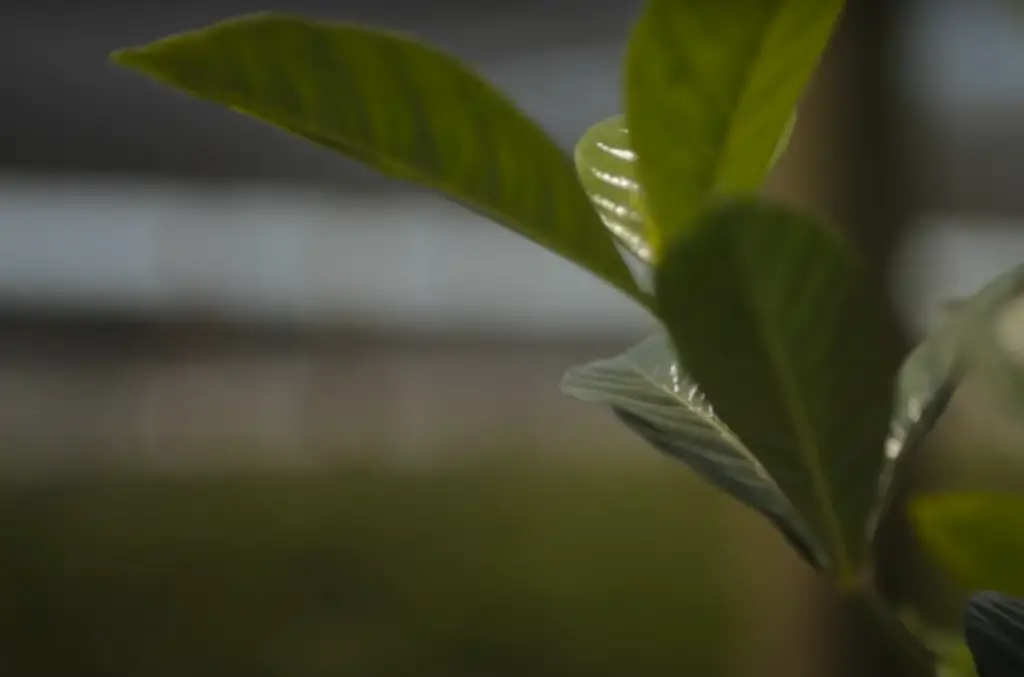
Never prune Gardenias in midsummer or during fall – this will make them vulnerable to damage from frost. Late summer pruning can also stunt the growth of your Gardenia, making it unhealthy and less able to bloom when the time comes.
If you notice any dead branches or weak spots during the growing season, you may want to consider removing them immediately for aesthetic reasons. Just remember not to do too much pruning at once and be sure to leave some healthy foliage on your plant!
Prune Gardenias After Flowering
One of the most important times to prune Gardenias is after flowering. Pruning just after it has finished blooming allows you to shape and trim the shrub while still promoting future flowers!
Avoid using scissors or shears, because they tend to crush the stem rather than cutting it.Outside of post-flowering pruning, Gardenias should be lightly trimmed every few months throughout the year in order to maintain their shape and encourage bushier growth. This type of light trimming can also help prevent your Gardenia from becoming too large for its space. Whenever doing any kind of pruning though, it’s best to err on the side of caution and not take off too much.
Finally, Gardenias are susceptible to pests and diseases so make sure you keep an eye out for any tell-tale signs of damage or infestation. Prune away any dead branches or leaves that show evidence of disease or pests, as this will help prevent the problem from spreading further within your garden.
Can I Prune Gardenias In Winter?
Winter is not a good time of year to prune gardenias. The plant may suffer stress from the cold temperatures and lack of sunlight, which could cause it harm. If you need to do some light maintenance, such as removing any dead or dying branches, winter is an acceptable time for this. But other than that, pruning should be avoided during the winter months.
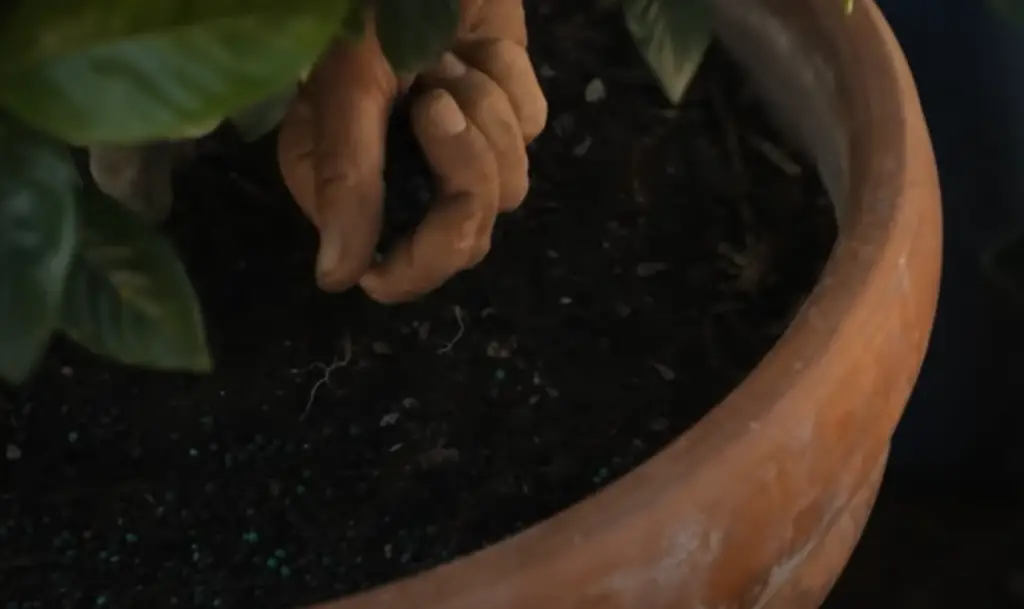
It’s best to wait until spring before performing major pruning on your gardenia bush. This will give the plant enough time to recover and thrive without being damaged by winter weather conditions. Spring is also a great time to fertilize gardenias in order to encourage new growth and promote blooming.
If you’re looking for a specific time to prune gardenias in spring, the best time is right before new growth begins. This usually occurs in early spring, so keep an eye on the plant and wait until you see signs of new growth before pruning. That way, you won’t be trimming off any budding flowers.
Should You Deadhead Gardenias?
The answer to this question is a resounding yes! Deadheading your gardenia can help it look its best and ensure blooms throughout the season.
It’s especially important to remove any dead flowers from the plant, since old blooms can sap the energy needed for new ones to form. Also, if left in place, these flowers could turn into seed pods which will take away from your gardenia’s aesthetic appeal.
To deadhead your gardenia, simply snip off each flower stem at the base of the bloom when it starts to wilt or fade. It’s also worth removing any leaves that have yellowed or browned. This helps improve air circulation around the plant and lets more light reach the blooms, helping them stay in their best condition. [1]
By deadheading your gardenia regularly throughout the season, you can keep it looking its best and prolong your flowering time!
How to Prune Gardenias for Healthy, Happy Blooms
Pruning is an important part of keeping your Gardenia healthy and happy. Pruning allows the plant to develop a strong structure, encourages bushier growth, and helps promote larger blooms. It can also help control disease and pest infestations. But when should you prune your Gardenia?
The best time to prune your Gardenia depends on where you live and what type of climate you have. In general, if you are located in a cooler climate, it’s best to perform light pruning during the early spring before new growth begins. However, if you’re in a warmer climate, it’s more beneficial to wait until late summer or fall before pruning. This will give the plant time to recover before winter sets in.
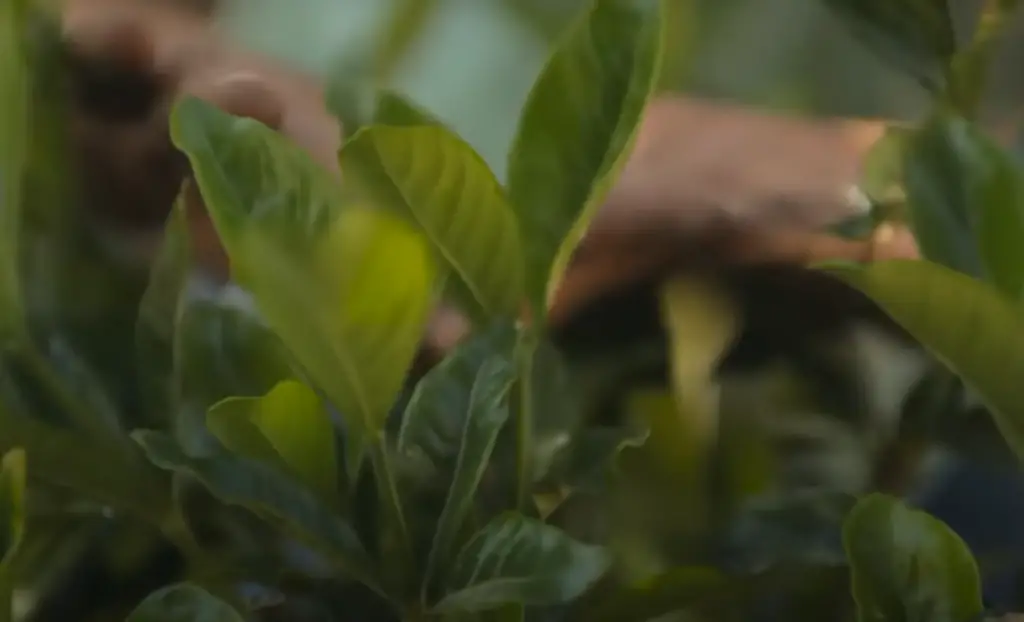
When you are ready to prune, be sure to use sharp, clean gardening shears and cut just above the leaf node. This will help promote a stronger structure and bushier growth. Removing dead or damaged branches is also important, as this can prevent disease and pest infestations from spreading throughout your gardenia. It’s also important to remember that different varieties of Gardenias require different amounts of pruning for optimal health. Be sure to research the specific variety of Gardenia you have so you know exactly how much pruning it requires.
Things You Should Know
Before you begin pruning, there are a few things to keep in mind. First of all, never prune more than one-third of the total plant at once. Doing so can cause shock and can permanently damage your Gardenia. Additionally, always make sure you wear protective gloves when handling gardening shears or other tools used for pruning. This will protect your hands from any cuts or scrapes that may occur during the process.
Removing Dead Stems
If you’ve noticed that your Gardenia has dead or wilting stems, it’s important to prune them back. Dead stems will sap nutrients and energy away from the bush, so they need to be removed as soon as possible. You should do this regularly throughout the growing season, as Gardenias are prone to diseases like root rot if left unchecked. To determine which parts of the plant need to be pruned off, carefully inspect each stem and look for any signs of decay or discoloration. If a stem is completely brown or black in color, then it should be safely trimmed away with sharp gardening shears. Make sure your shears are sterilized before use to prevent the spread of disease! Once all dead stems have been removed, healthy stems should be left to continue growing.
Pinch off dead stems with your fingers
One of the best ways to encourage new growth and promote shape is to pinch off dead stems with your fingers or pruning shears. Pruning can be done during both the spring and summer seasons as needed. Start by removing all dead, diseased, damaged, or crossing branches that are no longer growing actively. This will make it easier for the plant to focus its energy on healthy growth.
“Deadhead” your gardenia bush once a week during blooming season
During this time, make sure to cut off the old flowers directly below the blossom so that new buds can form and take their place.

Once flowering has stopped for the season, you can trim back your gardenia bush slightly by cutting away any dead wood or branches that don’t look healthy. This will help it to retain its shape as well as promote adequate air flow to keep it healthy. When doing this type of pruning, be sure not to cut into any green growth since this could damage your plant’s health.
You should also conduct light trimming during winter when your gardenia is not actively blooming. Cut away unhealthy looking stems or twigs using sharp pruners – again being careful not to trim away green stems. Keeping your gardenia trimmed back this way will encourage it to produce more blooms when the new season comes around.
Time your pruning right
If you want to prune your gardenia, timing is key. Pruning at the wrong time may cause problems for your plant. The best time to prune a gardenia is during its dormant period, which usually occurs in late winter or early spring before new growth appears. During this time, the plant is less likely to be damaged by cold temperatures and pests because it’s not actively growing.
When the plant does begin to show signs of life again (you’ll notice small buds emerging from the branches), stop pruning as any further cutting back could damage these delicate buds and prevent them from blooming. Similarly, avoid pruning during late summer as this will affect flower production for the following season.
To get the best possible results from your gardenia, it’s important to time your pruning correctly. Doing so will ensure that your plant remains healthy and blooms in abundance for many years to come!
Pruning for Shape, Size, and Growth
One of the most important reasons to prune a gardenia is to shape the tree or shrub, keep it at a desired size, and promote healthy growth. Pruning for these purposes should be done in late winter or early spring when the plant is dormant. You’ll want to cut back any branches that seem overly long or spindly, as well as those that are crossing over each other. This helps avoid overcrowding and encourages new growth in the right direction.

It’s also a good idea to remove some of the inward-facing buds and shoots, which can stunt future growth. Keep an eye out for dead wood and broken branches, which you should trim away completely. If your gardenia is planted in a pot, it’s important to prune down the roots and remove any that are circling around the edge of the pot.
Finally, if your gardenia has become overly large for its spot in your garden or yard, you can carefully trim it back until it’s more manageable. This should only be done as a last resort, however, since gardenias don’t respond well to drastic changes. Pruning too much (or too late) can cause serious damage to the plant. Make sure you know what you’re doing before taking on such a project!
Use standard pruning shears
When you’re ready to prune your Gardenia, it’s important that you use the right tools. The best tool for this job is a pair of standard pruning shears. Use a sharp blade and make sure to disinfect them before and after each use. This will help prevent the spread of disease and fungus in your garden. Avoid using scissors, knives or any other type of cutting implement that could damage or harm the plant.
Disinfect your shears (and saw, if needed) before using them
If you’re using hand shears, it’s important to make sure that they’re disinfected before pruning your gardenia. This will help prevent the spread of disease and infection to your plant. If you’re also using a saw to cut larger branches, it should be disinfected as well. To do this, carefully wipe down the blades with rubbing alcohol or a solution of equal parts water and white vinegar.
Step back to determine the size and shape of your gardenia bush
Before you begin pruning your gardenia shrub, it’s important to take a step back and assess what the ideal size and shape of the shrub should be. A gardenia bush should generally have an oval shape with three to five main stems coming from the base. Depending on the size of your gardenia shrub, this might mean removing some of its branches or stems to give it the desired shape. Taking a look at the overall structure before you start pruning will help ensure that you’re able to achieve the desired result in fewer snips.
Hold the pruning shears at a 45-degree angle to the branch
When it comes to pruning a gardenia, the most important thing is to make sure you are taking off the right branches. Start by evaluating your gardenia for any dead or diseased branches and remove those first. After that, determine which branches need to be cut and from where.
When working on thin or delicate branches, use sharp bypass hand pruners instead of anvil-style pruners as they won’t crush stems as anvil-style pruners can.When cutting a branch, be sure to cut at the point where it intersects with another branch or the main stem. Make sure you don’t leave any stubs sticking out as these can be unsightly and open up wounds on your gardenia that could become infected. After pruning, make sure to discard any clippings away from the plant as they may contain disease organisms.
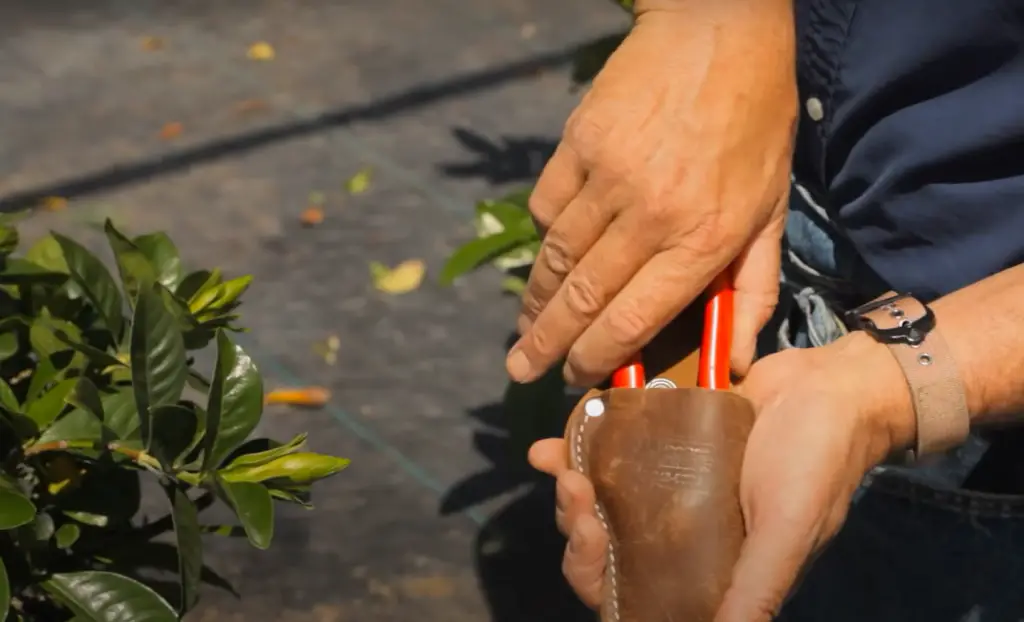
With proper pruning techniques, your gardenia will look beautiful and stay healthy for years to come! Remember, when in doubt it’s always better to err on the side of caution and not cut too much off – you can always do more pruning if needed later on down the line. So get out there and get pruning!
Cut away half of the oldest branches at the trunk
When you are ready to prune your gardenia, begin with the oldest branches at its trunk. Cut away about half of them with a pair of sharp and clean secateurs. Make sure that each cut is made just above a leaf node or bud, so that it can easily be replaced by new growth in its place. This step will help promote bushier growth and ensure that your gardenia remains well-shaped over time.
After removing these older branches, take a look at the remaining ones to determine if they need any additional trimming. If any have become too long or unruly, you can shorten and shape them accordingly. Just make sure not to remove more than one-third of the total branch length at once as this can put too much stress on the plant.
Trim the remaining branches down to your desired height and shape
Once you have the main structure of your Gardenia, you will need to trim away any excess growth to give it a neat and attractive shape. You can use either shears or pruning saws to do this. Make sure that you cut the branches at least an inch from their base so that they are not damaged by frost or disease. It’s important to remember that Gardenias prefer plenty of light and air circulation, so don’t be too aggressive when removing growth – just tidy it up!
It’s also important to make sure that all of your cuts are cleanly made with sharp tools. Ragged edges can prevent wounds from healing properly, which can lead to infection in your shrub. Finally, always remove any dead or diseased wood from the plant as soon as you spot it to prevent any further spread of disease.
Prune most where you want to encourage growth
Gardenias are hardy plants that don’t require a lot of pruning in order to survive and thrive, but there are certain times when it is beneficial to prune them. Pruning at the right time can encourage growth, produce more blooms, and generally make your gardenia look better. Generally speaking, you’ll want to prune most where you want to encourage growth.
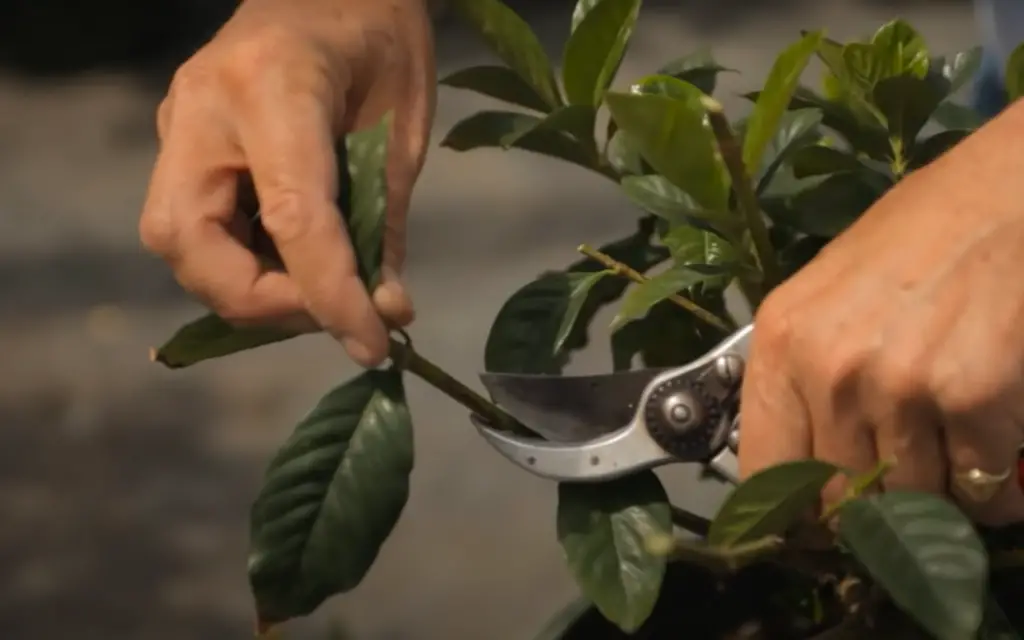
If you’re looking to encourage new buds, then you should prune back any dead or dying branches first. When you do this kind of maintenance-driven pruning, be sure not to cut off too much — you only need enough for the plant’s shape and size. You can also pinch off young growth in order to force branching and create bushier plants.
You can also prune back your gardenia plant at the end of winter in order to encourage new growth. Cut off any dead or damaged branches, as well as any that seem to be growing too far outwards from the main stem. Prune judiciously, though — you don’t want to cut too much away, or you’ll stunt the plant’s growth.
Finally, consider pruning your gardenia when it starts to become overgrown. This will help keep your plant looking neat and tidy, while still allowing it to produce flowers and foliage as it should. Just be careful not to take off more than a third of the branch length during any single pruning session.
For best results, consider pruning your gardenia during the early spring months — this is when it will be most likely to respond positively to trimming and produce beautiful blooms all season long. With a bit of regular maintenance and careful pruning, you’ll have a gorgeous gardenia that stands out from the rest!
Maintaining Your Gardenia Bush
Pruning your Gardenia bush is an important part of maintaining it. Pruning allows you to shape and encourage new growth, reduce the risk of disease, and keep your bush healthy. When you prune a Gardenia bush, you are essentially thinning out some of its branches, allowing for more light and air circulation in the center of the plant.
During early spring, cut back any dead or diseased branches as well as any weak shoots that are not growing vigorously. Make sure to sterilize your pruning shears with rubbing alcohol before pruning, and clip the branches at an angle just above a bud.
Midsummer is the ideal time to make more extensive pruning cuts. If your Gardenia bush has become too tall or out of shape, you can cut it back by up to one-third of its size. Be sure to avoid cutting off any flowering buds when pruning in midsummer as this will reduce the number of blooms you get later in the season. Sterilize your shears with rubbing alcohol and use them to remove any dead wood, crossed branches, or suckers growing from below the graft point on your plant. Again, clip just above a bud at an angle for best results.
Water your gardenias regularly
Watering your gardenias regularly is essential for them to stay healthy and thrive. During the summer months, check the soil moisture twice a week to make sure it’s damp but not saturated. When soil becomes too wet, the roots can’t access oxygen which will cause the plant stress.
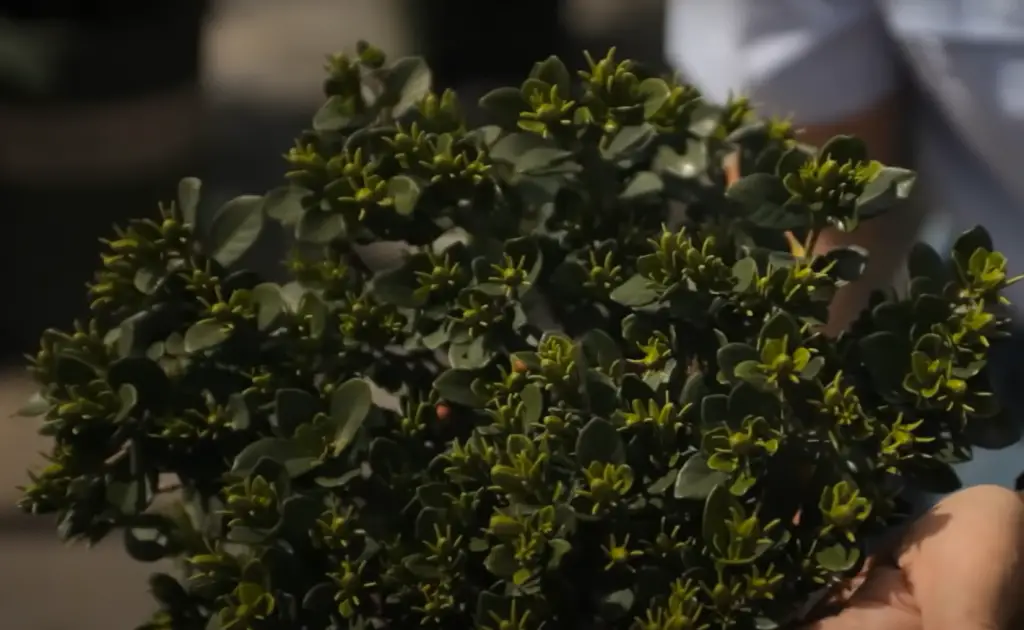
Also, be careful not to overwater as this will also cause root rot or other diseases in your gardenia. To reduce water evaporation in hot weather, try adding mulch around the plant’s base as this helps keep the soil temperature cool and moist.
Fertilize your gardenia bush 2 to 3 times per year
Fertilizing is important to ensure your gardenia has the nutrients it needs for healthy growth and flowering. Pruning should be done after fertilizing, as this can help stimulate new growth which will appear shortly after pruning.
For most varieties of gardenias, it’s best to do the majority of your pruning in early spring before buds form. This is because you won’t want to cut away any flower buds that may have already formed on the bush if you wait too late in the season to prune. When pruning, start by removing any dead wood or branches that are diseased or damaged. You’ll also want to selectively trim back long branches that are outgrowing other parts of the bush, as well as remove any suckers that may have appeared at the base of the plant.
Using pruning tools such as shears and loppers will help you achieve a nice neat shape for your gardenia. Try to avoid using larger saws or axes on more delicate plants; they can cause damage to the surrounding branches and leaves. Finally, be sure to clean your pruning tools between cuts with rubbing alcohol or an antibacterial cleaner to prevent spreading any diseases from one part of the bush to another. This will help keep your gardenia healthy and looking its best all season long!
Check for bugs on your gardenias
Pesky bugs like scale and aphids can be a real issue when it comes to gardening. If you notice any signs of these bugs on your gardenias, it’s best to take care of them before proceeding with pruning. The best way to get rid of these pests is through insecticidal soap or horticultural oil sprays, which should help in getting rid of the problem quickly.[2]
Gardenia Pruning Tips
When it comes to pruning your gardenia, timing is key. Pruning too early or late can cause damage to the plant and minimize blooming.
In general, you should wait until the start of spring – just before new growth begins – to prune back any overgrown branches or dead parts of the plant. This will help stimulate new growth and encourage more flowers in the summer months. If you need to remove deadheads during winter to tidy up the plant, that’s also okay; however, avoid major pruning at this time as it will put extra stress on the plant when it needs energy for other tasks like flowering later in spring.
Also thin out branches for improved air circulation. This should be done cautiously, though – gardenias don’t respond well to drastic pruning and it’s best not to take off more than 1/3 of the stems in one go.
Finally, make sure you clean your pruning tools before and after each use. Prune away any dead or diseased branches with sterilized scissors or shears to avoid spreading disease among plants. Afterward, dip the blades into rubbing alcohol or a bleach solution to disinfect them for further use.
FAQ
How far can you cut back gardenias?
You can cut gardenias back to 6 inches above the ground if you need to. This will encourage new growth from the base of your plant and help it look fuller.

However, keep in mind that pruning too much or too often can be harmful to a gardenia’s health and may limit its flowering potential. It is best to only trim away dead branches or branches that have grown out of control. [3]
Should you cut back gardenias?
The answer to this question really depends on the purpose of your pruning. Gardenias are relatively low-maintenance plants, and in most cases, you don’t need to trim them at all. However, if you do decide to give your gardenia a makeover, there are certain times of the year when it is best to do so.
The most common reason for pruning gardenias is simply to keep them looking neat and tidy. If you plan on doing this kind of light maintenance trimming, it’s best to do it early spring before new growth appears. This will allow the plant to focus its energy on growing new shoots rather than trying to heal any wounds from pruning too late.
You may also want to prune your gardenia if it’s becoming overgrown or is not flowering the way you would like. In this case, it’s best to wait until after it has finished blooming in mid-summer before giving it a serious trim. This will ensure that you won’t be cutting off any of the flowers and buds that are still developing.
Finally, if you need to completely reshape your gardenia, such as when creating a topiary, then you can prune at any time of year. However, keep in mind that this kind of drastic pruning should only be done occasionally – no more than once every few years or so – otherwise you risk stunting the growth of your plant. [4]
Can you cut a gardenia to the ground?
It is not recommended to cut a gardenia to the ground – doing so will almost certainly kill it. If you need to remove damaged, diseased or dead branches from your Gardenia, prune them off near the base of the stem (where it enters the main plant). This will help maintain a desirable shape and size of the plant while also removing any unhealthy branches.
If you want to drastically reduce the size of your Gardenia without killing it, then practice hard pruning. Prune back as much as one-third to one-half of its size in early spring before new growth begins. Make sure that there are still healthy leaves and stems left on the plant after pruning and avoid over-pruning. [5]
How do you cut gardenias?
Gardenias are best pruned in early spring before new growth begins. The flowers themselves should not be cut, as this can cause the plant to stop flowering. To properly prune gardenias, start by removing dead or diseased branches and stems. Then, use sharp bypass hand-pruners to make clean cuts at a 45-degree angle just above a bud that is facing outward from the center of the plant. You should avoid cutting into old wood since it won’t regenerate; instead focus on removing only basal shoots and suckers. When finished, lightly shape your gardenia with light trimming and thinning out of too tightly packed branches and stems while avoiding heavy pruning if possible. Finally, keep in mind that gardenias are slow-growing plants and should not be subject to frequent pruning. Prune your plants only when necessary to keep them healthy and looking their best!
Useful Video: How to Prune Potted Gardenias Indoors & Outdoors : Garden Savvy
Conclusion
Pruning a gardenia is important for ensuring healthy growth and abundant blooms. Pruning should be done before new growth appears, as this will keep the plant compact and reduce overcrowding. Proper pruning techniques are also important, so it’s best to use sharp shears or scissors to make clean cuts near the branch collar. With regular pruning and care, your gardenia will be a beautiful addition to your outdoor space! Happy gardening!
References:
- https://www.homesandgardens.com/gardens/when-to-prune-gardenias
- https://www.wikihow.com/Prune-a-Gardenia-Bush
- https://plantaddicts.com/pruning-gardenias/
- https://www.southernliving.com/garden/grumpy-gardener/when-can-i-cut-back-gardenia
- https://www.gardenfine.com/how-to-trim-gardenia-bushes/










Leave a Reply
View Comments